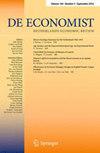信息不对称条件下实物期权投资时机和投资数量的扭曲
IF 2.3
4区 经济学
Q2 ECONOMICS
引用次数: 0
摘要
摘要本文分析了投资成本信息不对称条件下的实物期权投资决策,该决策不仅涉及投资时机,还涉及投资数量。委托人,即监管者,向代理人(被监管的公司)提供一份合同清单。受监管的公司比监管者拥有更好的成本信息,最优监管可以平衡投资决策的扭曲和留给公司的信息租金。在非动态情况下,众所周知,最优契约涉及投资数量的向下扭曲。在动态的实物期权情况下,投资时机也会出现扭曲:高成本企业的投资将被推迟到最优时间之后,直到收入达到更高的投资门槛。在收入随机过程的不同假设条件下,探讨了实物期权监管对投资数量的影响。一方面,提高投资门槛有利于增加投资数量,而筛选高成本企业则有利于减少其投资数量。我们找到了后一种减量化效应占主导地位的一个简单的充分条件,并证明它对广泛的常用随机过程是满足的。本文章由计算机程序翻译,如有差异,请以英文原文为准。
Distortions in Investment Timing and Quantity in Real Options with Asymmetric Information
Abstract We analyze real options investment under asymmetric information on investment costs, where decisions not only involve investment timing, but also investment quantity. A principal, the regulator, offers a menu of contracts to the agent (the regulated firm). The regulated firm has better information on costs than the regulator, and the optimal regulation trades off distortions in investment decisions and informational rents left to the firm. In a non-dynamic situation, it is well known that optimal contracts involve downward distortions on investment quantity. In the dynamic, real options situation, distortions also occur in investment timing: a high-cost firm’s investment will be delayed beyond the optimal time, until revenues reach a higher investment threshold. We explore the effect on investment quantity in this real option regulation under various assumptions on the stochastic process for revenues. On the one hand, the higher investment threshold tends to increase investment quantities, whereas screening of high-cost firms would favour reducing their investment quantity. We find a simple sufficient condition for the latter, quantity-reducing, effect to dominate, and show that it is satisfied for a wide range of commonly used stochastic processes.
求助全文
通过发布文献求助,成功后即可免费获取论文全文。
去求助
来源期刊

Economist-Netherlands
ECONOMICS-
CiteScore
2.90
自引率
12.50%
发文量
19
期刊介绍:
Since 1852, De Economist, the Netherlands Economic Review, has provided an outlet for high quality research in economics. Emphasizing European issues, it offers insightful studies that deal with theoretical issues as well as applied work. The journal also publishes important surveys of current research. Authors of articles based on empirical research are required to make their datasets available to readers, enabling them to replicate the research results.
Officially cited as: De Economist
 求助内容:
求助内容: 应助结果提醒方式:
应助结果提醒方式:


